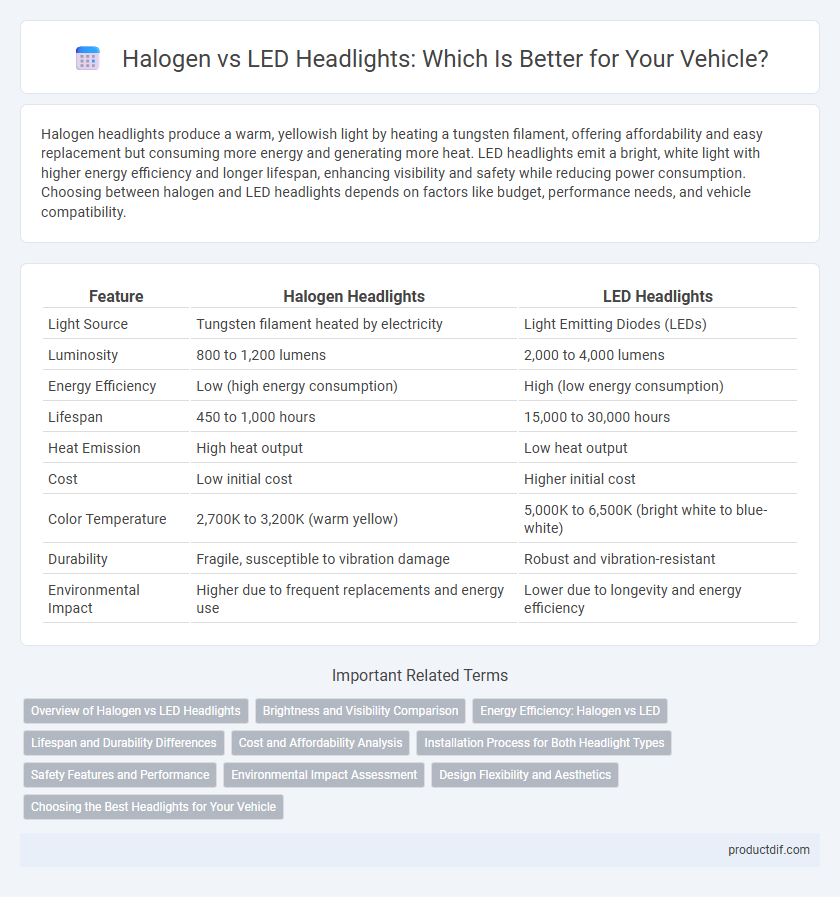Halogen headlights produce a warm, yellowish light by heating a tungsten filament, offering affordability and easy replacement but consuming more energy and generating more heat. LED headlights emit a bright, white light with higher energy efficiency and longer lifespan, enhancing visibility and safety while reducing power consumption. Choosing between halogen and LED headlights depends on factors like budget, performance needs, and vehicle compatibility.
Table of Comparison
| Feature | Halogen Headlights | LED Headlights |
|---|---|---|
| Light Source | Tungsten filament heated by electricity | Light Emitting Diodes (LEDs) |
| Luminosity | 800 to 1,200 lumens | 2,000 to 4,000 lumens |
| Energy Efficiency | Low (high energy consumption) | High (low energy consumption) |
| Lifespan | 450 to 1,000 hours | 15,000 to 30,000 hours |
| Heat Emission | High heat output | Low heat output |
| Cost | Low initial cost | Higher initial cost |
| Color Temperature | 2,700K to 3,200K (warm yellow) | 5,000K to 6,500K (bright white to blue-white) |
| Durability | Fragile, susceptible to vibration damage | Robust and vibration-resistant |
| Environmental Impact | Higher due to frequent replacements and energy use | Lower due to longevity and energy efficiency |
Overview of Halogen vs LED Headlights
Halogen headlights use tungsten filaments heated to produce light, offering a warm yellowish glow with lower energy efficiency and shorter lifespan compared to LED headlights. LED headlights rely on semiconductor diodes that emit bright, white light with higher energy efficiency, longer durability, and improved brightness for better road visibility. In automotive lighting, LED headlights provide enhanced performance and reduced maintenance costs, making them a preferred choice over traditional halogen bulbs.
Brightness and Visibility Comparison
LED headlights offer significantly higher brightness levels, typically around 3,000 lumens, compared to halogen headlights which emit approximately 1,000 to 1,500 lumens, resulting in improved nighttime visibility. The colder color temperature of LED lights, ranging from 5,000K to 6,500K, produces a whiter, more natural light that enhances contrast and reduces eye strain. Halogen headlights, with warmer color temperatures around 3,200K, provide less intensity and shorter beam range, impacting overall road visibility during night driving.
Energy Efficiency: Halogen vs LED
LED headlights consume significantly less energy than halogen headlights, typically using about 85% less power while producing brighter and more focused light. Halogen bulbs operate by heating a tungsten filament, which leads to higher energy consumption and more heat generation compared to LEDs that use semiconductor technology for illumination. The superior energy efficiency of LED headlights not only reduces the electrical load on a vehicle's alternator but also extends battery life and can improve overall fuel economy.
Lifespan and Durability Differences
Halogen headlights typically last between 500 to 1,000 hours, whereas LED headlights can endure up to 25,000 hours, significantly reducing the frequency of replacements. The durability of LED headlights is enhanced by their solid-state design, making them more resistant to vibrations and impacts compared to the fragile filaments in halogen bulbs. This extended lifespan and increased resilience make LED headlights a more reliable and cost-effective lighting solution for vehicles over time.
Cost and Affordability Analysis
Halogen headlights typically cost between $15 and $45 per bulb, making them the most affordable option for most vehicle owners. LED headlights, while more expensive with prices ranging from $50 to $200 per bulb, offer longer lifespan and higher energy efficiency, which can lead to cost savings over time. The upfront cost difference is offset by LEDs' durability and reduced replacement frequency, but halogens remain the preferred choice for budget-conscious buyers.
Installation Process for Both Headlight Types
Halogen headlights feature a straightforward installation process involving simple bulb replacement, compatible with most standard vehicle sockets and requiring minimal tools. LED headlights often require additional components such as ballasts or drivers, making their installation slightly more complex and potentially necessitating vehicle-specific adapters or modifications. While halogens offer quick plug-and-play installation, LEDs provide longer lifespan and energy efficiency benefits despite a more involved setup.
Safety Features and Performance
Halogen headlights emit a warm light that offers moderate visibility and are generally less expensive but have a shorter lifespan and lower energy efficiency compared to LED headlights. LED headlights provide brighter, whiter light with higher luminance and a longer range, significantly improving nighttime visibility and reaction time, which enhances overall driving safety. Their rapid illumination and durability under various weather conditions contribute to superior performance and reduced maintenance costs over time.
Environmental Impact Assessment
Halogen headlights consume more energy and produce higher carbon emissions compared to LED headlights, making LEDs a more environmentally sustainable choice. LEDs have a longer lifespan, reducing waste and the frequency of replacements, which contributes to lower environmental impact over time. The reduced power consumption of LED headlights also lessens the load on vehicle electrical systems, improving overall fuel efficiency and decreasing greenhouse gas emissions.
Design Flexibility and Aesthetics
LED headlights offer greater design flexibility and aesthetics compared to halogen headlights, allowing manufacturers to create sleek, modern shapes that enhance a vehicle's overall look. Their compact size and ability to be arranged in intricate patterns enable innovative lighting designs not feasible with the bulkier halogen bulbs. This advancement contributes to a vehicle's distinctive styling while improving nighttime visibility and energy efficiency.
Choosing the Best Headlights for Your Vehicle
Halogen headlights offer a warm light and are cost-effective, making them suitable for budget-conscious drivers, while LED headlights provide brighter illumination, longer lifespan, and improved energy efficiency, enhancing nighttime visibility and safety. When choosing the best headlights for your vehicle, consider factors like driving conditions, vehicle compatibility, and maintenance costs. Upgrading to LED headlights can significantly enhance road visibility and reduce energy consumption, benefiting long-term vehicle performance.
Halogen Headlights vs LED Headlights Infographic

 productdif.com
productdif.com